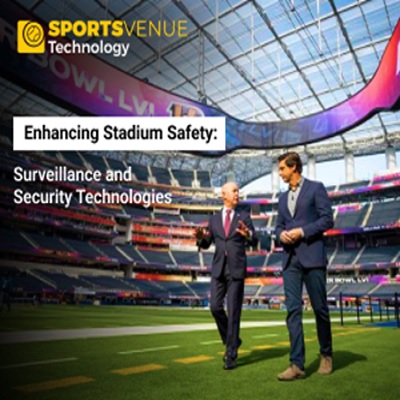Enhancing Stadium Safety: Surveillance and Security Technologies

Introduction
In the heart-pounding excitement of a live game or a pulsating concert, the safety of every individual present becomes the primary concern. It is not just about experiencing the thrill; it's about ensuring that everyone feels secure and protected within the stadium's premises. With the rapid evolution of technology, stadiums worldwide are now embracing innovative measures to fortify their security protocols, guaranteeing the safety and peace of mind of every attendee.
A) Surveillance Systems: Watching Every Move
The Role of High-Definition Cameras
Strategically positioned, high-definition cameras act as vigilant sentinels, capturing every corner and angle of the stadium with unmatched precision. These cameras are not merely passive observers; they are equipped with intelligent monitoring systems that can swiftly detect any irregular activities or suspicious behavior, enabling security personnel to respond promptly and effectively.
Intelligent Monitoring Systems: Detecting Suspicious Behavior
Integrated with advanced algorithms, these monitoring systems can distinguish normal crowd movements from potential security threats, allowing security personnel to preemptively address any untoward incidents before they escalate. Through real-time monitoring and analysis, these systems ensure that every corner of the stadium remains under constant surveillance, creating a secure environment for all attendees.
B) Facial Recognition: Identifying Potential Threats
Enhancing Security with Advanced Facial Recognition
Incorporating cutting-edge facial recognition technology has become a game-changer in the realm of stadium security. By cross-referencing the faces of attendees with comprehensive databases, security personnel can swiftly identify individuals with a history of disruptive behavior or those posing potential threats, ensuring a proactive approach to security.
Leveraging Databases for Proactive Measures
The integration of facial recognition technology with extensive databases allows security personnel to anticipate and prevent security breaches before they occur. By swiftly identifying individuals with a history of misconduct, the system acts as a strong deterrent against potential wrongdoers, creating a safer environment for all spectators.
C) Access Control Measures: Regulating Entry for Authorized Access
Modernized Entry Systems and Ticketing Protocols
Today's stadiums boast cutting-edge ticketing and entry systems that not only expedite the entry process but also guarantee access exclusively to authorized individuals. These advanced systems not only streamline crowd management but also play a pivotal role as the primary deterrent against unauthorized access and counterfeit ticketing scams.
Biometric Scanners and RFID Technology for Authentication
Integrating biometric scanners and RFID technology into the access control process further strengthens security measures, ensuring that only verified individuals gain entry. By authenticating the identity of every attendee, these advanced systems leave no room for unauthorized access, bolstering the overall security framework of the stadium.
D) Aerial Surveillance: Drones as Eyes in the Sky
Utilizing Drones for Comprehensive Stadium Monitoring
Equipped with high-resolution cameras and real-time video transmission capabilities, drones offer an aerial perspective that complements ground-based surveillance, providing security personnel with an all-encompassing view of the entire stadium. This aerial surveillance not only helps identify potential security breaches but also assists in managing large crowds efficiently, ensuring the safety of all attendees.
Bridging the Gap with Ground-Based Surveillance
By bridging the gap between ground-based surveillance and aerial monitoring, drones serve as a crucial component in the comprehensive security network of stadiums. Their ability to swiftly identify security threats from a bird's-eye view enables security personnel to take timely and appropriate actions, reinforcing the safety of the stadium and its attendees.
E) Effective Communication Networks: Coordinated Response in Emergencies
Streamlining Communication among Security Personnel
Modern stadiums are equipped with highly efficient communication networks that enable seamless coordination among security personnel, medical teams, and management staff. This streamlined communication ensures that in the event of any emergency, be it a medical crisis or a security threat, the response is swift, well-coordinated, and effective, minimizing the impact and ensuring the safety of every individual present.
Ensuring Swift Response to Medical Emergencies and Security Threats
The integration of robust communication systems not only facilitates a swift response to security threats but also ensures that medical emergencies are addressed promptly. By enabling real-time communication between different departments, stadiums can effectively manage any crisis, guaranteeing the safety and well-being of every attendee.
F) Securing the Digital Framework: Prioritizing Cybersecurity Measures
Ensuring the Safety of Online Transactions and Sensitive Information
With the growing dependence of stadiums on digital ticketing systems, online transactions, and live streaming services, the criticality of safeguarding digital infrastructure has surged. The implementation of robust cybersecurity measures is indispensable to shield sensitive data and preempt any potential breaches that might jeopardize the integrity of the stadium's digital ecosystem.
Mitigating Cyber Threats Targeting Stadiums
By deploying advanced cybersecurity protocols, stadiums can effectively mitigate the risks posed by cyber threats. Implementing measures such as encryption, multi-factor authentication, and regular security audits fortify the digital infrastructure, ensuring that the stadium's online operations remain secure and resilient against potential cyber-attacks.
G) Conclusion: A Secure Haven for Uninterrupted Entertainment
The fusion of cutting-edge surveillance technologies, robust access control systems, proactive aerial surveillance, seamless communication networks, and fortified cybersecurity measures has transformed stadiums into fortresses of entertainment, where safety and enjoyment coexist harmoniously. As technology continues to advance, the future of stadium safety looks even more promising, promising an atmosphere where every fan can cheer for their favorite team or artist with peace of mind, knowing that their security is prioritized above all else.
The evolution of stadium safety through the integration of surveillance and security technologies represents a significant step forward in the commitment to providing a secure and enjoyable experience for every individual attending a live event. Beyond the technological advancements, the underlying ethos of these measures underscores the dedication of stadium authorities and security personnel to prioritize the well-being of their patrons above all else.
In an age marked by escalated security considerations, the comprehensive strategy adopted by stadiums to strengthen their security framework reflects their proactive stance in ensuring seamless event operations devoid of any untoward occurrences. The integration of smart surveillance, cutting-edge access control, aerial supervision, efficient communication, and resilient cybersecurity measures is redefining the benchmarks for safety and protection in the domain of managing large-scale events.
As we look ahead to the future, the ongoing advancements in technology promise even more sophisticated and efficient solutions to bolster stadium security. From the seamless integration of artificial intelligence to the continual refinement of surveillance systems, the focus remains steadfast on creating an environment where every fan can immerse themselves in the excitement of the moment, knowing that their safety is prioritized and protected at every step.





